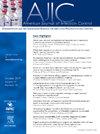Seasonality of surgical site infection rates across a broad surgical sample and diverse health system
IF 3.8
3区 医学
Q2 INFECTIOUS DISEASES
引用次数: 0
Abstract
Background
Prior data suggest that surgical site infections (SSIs) occur more frequently in warmer months. Although several studies have shown this, most do not adequately account for confounding factors or the non-parametric nature of seasonal trends. This study examined SSI rates across multiple hospitals within a single healthcare system, using previously published statistical models applied to electronic health record (EHR) data.
Methods
We retrospectively analyzed all surgeries from 2014 to 2019. Preoperative risk and postoperative probabilities of SSIs were estimated using our Automated Surveillance of Postoperative Infections (ASPIN) models. Observed to expected (O/E) ratios were calculated and plotted by week, with cubic smoothing splines visualizing trends. Seasonality was modeled using generalized linear mixed models with sine and cosine transformations of the week of the year or quadratic transformations as predictors.
Results
348,289 surgeries were analyzed. Most SSIs occurred between July and August. The risk-adjusted O/E ratio and postoperative SSI probabilities significantly increased (P < 0.05) during the summer in Region 1, an academic hospital, but not in the other two regions.
Conclusions
Our study supports prior work suggesting a summer peak in SSIs but not a distinct July spike. We incorporated novel statistical models to predict preoperative risk and postoperative probability of SSI.
手术部位感染率的季节性在广泛的手术样本和不同的卫生系统。
背景:过去二十年的数据表明,手术部位感染(ssi)在温暖的月份更频繁发生。虽然有几项研究探讨了ssi的季节性,但大多数研究没有充分考虑混杂因素或季节性趋势的非参数性质。本研究旨在检查单一医疗保健系统内多家医院手术后SSI率,使用先前发表的应用于电子健康记录(EHR)数据的统计模型。方法:我们回顾性分析了2014年至2019年不同医疗系统的所有手术。使用我们之前发表的术后感染自动监测(ASPIN)模型估计ssi的术前风险和术后概率。观察到的预期(O/E)比率按周计算并绘制,三次平滑样条用于可视化趋势。季节性使用广义线性混合模型建模,该模型采用一年中的一周的正弦和余弦变换或二次变换作为预测因子。结果:共分析348,289例手术。大多数ssi发生在7月至8月。专科医院1区夏季风险调整后的O/E比和术后SSI概率显著升高(P < 0.05),其他2区无显著升高。术前风险也在7月左右增加,但不明显。结论:我们的研究支持了先前的研究,表明ssi在夏季有一个显著的高峰,而不是在7月份出现一个特定的高峰。我们采用了新的统计模型来预测SSI的术前风险和术后概率。
本文章由计算机程序翻译,如有差异,请以英文原文为准。
求助全文
约1分钟内获得全文
求助全文
来源期刊
CiteScore
7.40
自引率
4.10%
发文量
479
审稿时长
24 days
期刊介绍:
AJIC covers key topics and issues in infection control and epidemiology. Infection control professionals, including physicians, nurses, and epidemiologists, rely on AJIC for peer-reviewed articles covering clinical topics as well as original research. As the official publication of the Association for Professionals in Infection Control and Epidemiology (APIC)

 求助内容:
求助内容: 应助结果提醒方式:
应助结果提醒方式:


